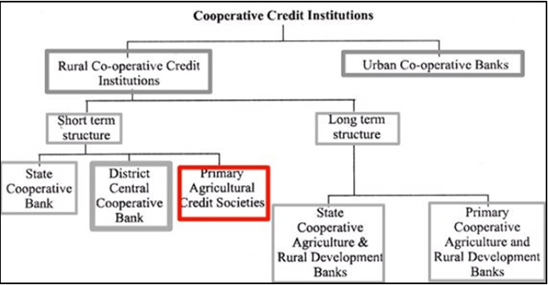Why in news?
- The Union Budget has announced Rs 2,516 crore for computerisation of 63,000 Primary Agricultural Credit Societies (PACS) over the next five years.
- This is aimed at bringing greater transparency and accountability in the operations of PACS and enabling them to diversify their business and undertake more activities.
What’s in today’s article?
- Co-operative credit system in India
- Primary Agricultural Credit Societies (PACS)
- News Summary
Overview of co-operative credit system in India:

- There are different types of cooperative credit institutions working in India. These institutions can be classified into two broad categories- agricultural and non-agricultural.
- Agricultural credit institutions dominate the entire cooperative credit structure.
- Agricultural credit institutions are further divided into short-term agricultural credit institutions and long-term agricultural credit institutions.
- The short-term agricultural credit institutions which cater to the short-term financial needs of agriculturists have three-tier federal structure —
- at the apex, there is the state cooperative bank (SCB) in each state;
- at the district level, there are central cooperative banks;
- at the village level, there are Primary agricultural credit societies (PACS).
What are PACS?
- PACS serve as the last link in a three-tier cooperative credit structure.
- Credit from the SCBs is transferred to the district central cooperative banks (DCCBs), that operate at the district level. The DCCBs work with PACS, which deal directly with farmers.
- Since these are cooperative bodies, individual farmers are members of the PACS, and office-bearers are elected from within them. A village can have multiple PACS.
What are the functions of PACS?
- PACS are involved in short term lending — or what is known as crop loan.
- At the start of the cropping cycle, farmers avail credit to finance their requirement of seeds, fertilisers etc.
- Banks extend this credit at 7 per cent interest, of which 3 per cent is subsidised by the Centre, and 2 per cent by the state government.
- Effectively, farmers avail the crop loans at 2 per cent interest only.
- Other functions include:
- Supplying of agricultural inputs including seeds, fertilizers, insecticides, etc.
- Maintaining the supply of the light machinery for the agricultural purpose.
- Providing marketing facilities that could enhance the sale of their agricultural products.
Performance of PACS
- A report published by RBI in December, 2022 put the number of PACS at 02 lakh.
- At the end of March 2021, only 47,297 of them were in profit.
- The same report said PACS had reported lending worth Rs 1,43,044 crore and NPAs of Rs 72,550 crore.
What are the advantages of PACS?
- It helps the farmers to get credit for agricultural purpose with minimal paperwork within a short time.
- With other scheduled commercial banks, farmers have often complained of tedious paperwork and red tape.
- It helps in promoting savings habits among its members.
- It helps in implementing any government schemes which are related to farmers at their level and also to observe whether these schemes are attaining their intended purpose or not.
What are the challenges associated with PACS?
- Organizational weakness: Though PACS covers the major portion of the villages, still villages in the north-eastern states are not covered.
- Over dues: The larger over-dues come from landowners rather than small cultivators, implying that a few farmers who are relatively stronger in the village took unfair advantage of these PACS.
- Lack of resources: The PACS's resources are far too limited in relation to the rural economy's short- and medium-term credit needs. This is largely due to insufficient funds provided by higher-level funding agencies.
News Summary
- Union Budget has announced Rs 2,516 crore for computerisation of 63,000 PACS over the next five years.
Budget 2023-24 and PACS
- Agriculture Accelerator Fund
- An Agriculture Accelerator Fund will be set up to encourage agri-startups by young entrepreneurs in rural areas.
- Increased agricultural credit target
- The agricultural credit target will be increased to Rs 20 lakh crore.
- Digital public infrastructure
- Digital public infrastructure for agriculture would be built as an open source, open standard and interoperable public good.
- Computerization of 63,000 PACS
Why is computerization of PACS needed?
- To bring about uniformity in the system
- While SCBs and DCCBs are connected to the Core Banking Software (CBS), PACS are not.
- Some PACS use their own software, but a compatible platform is necessary to bring about uniformity in the system.
- Efficiency in working and building trust
- The majority of PACS are functioning manually resulting in inefficiency and trust deficit.
- Hence, this step will increase the efficiency of PACS, bringing transparency and accountability in their operations.
- It will facilitate PACS to diversify their business and undertake multiple activities or services.
- Financial inclusion & strengthening of service delivery to farmers
- Computerization of PACS will serve the purpose of financial inclusion especially of Small & Marginal Farmers (SMFs).
- With computerization, PACS shall become nodal service delivery point for various services and provision of inputs like fertilizers, seeds etc.










